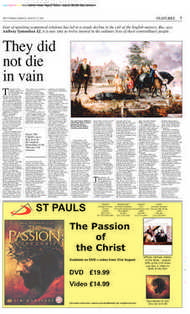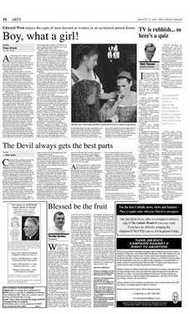Page 9, 27th August 2004
Page 9

Report an error
Noticed an error on this page?If you've noticed an error in this article please click here to report it.
Tags
Share
Related articles
If They Kill Me I Will Rise Again...
The Breathtaking Audacity Of Romero
Romero Died A Martyr, Say Jesuits
Justice For Oscar Romero At Last?
Echoes Of Becket In Romero Film
JUSTICE FOR A MARTYR
Let the cause of ‘San Romero’ proceed
“Who will rid me of this turbulent priest?” Thomas à Becket and Oscar Romero have much in common. Both were often unpopular with their fellow bishops; both underwent conversion as the Spirit revealed to them what their office demanded; both were martyred by secular authority in front of the altar; and both were declared saints and martyrs by public acclamation.
Their causes were different: Becket fought for the rights of Church against State; Romero fought for the defence of the Salvadoran poor, rubbed into the dirt – sometimes living, often dead – by a merciless oligarchy. He saw, with clarity, that the social and economic structures of El Salvador were intrinsically structures of injustice, and therefore of sin.
Romero did not make the mistake of adopting a version of liberation theology that saw these distorted structures in Marxist terms, but as an expression in time and place of the need for redemption in the hearts of every man. “Thus the poor have shown the Church the true way to go,” he said in 1980. “A Church that does not join the poor in order to speak out from the side of the poor against the injustices committed against them is not the true Church of Jesus Christ.” His love for the poor was expressed not only in magisterial statements but in his personal contacts. As one poor Salvadoran said: “He made me feel like a person, because he loved people like me, and he didn’t act like we made him sick. He talked to us, he touched us, he asked us questions. He had confidence in us. You could see it in his eyes that he cared about me.” But we ourselves cannot pass by on the road to the Jericho supermarket, no more than tut-tutting at the excesses in obscure countries. Every individual in the Western world shares collective responsibility for the injustices of trade barriers, the arms trade, crushing debt and the other instruments that rub the poor in their millions into the dirt (though these injustices are by no means the exclusive fault of the West). Preoccupied by theological trivia, we sometimes wonder what sign of contradiction the Church has to offer the world, a sign that can inspire men and women of goodwill. That sign can be found in the body of a dead archbishop lying by the altar in a hospital chapel on March 24, 1980.
Romero was far from popular with the secular establishment, whose greedy oppression he attacked; nor has he always been popular in all quarters of a Church that has historically compromised (often through myopic prudence) with existing power structures. Yet in Latin America the devotion of the poor mirrors the devotion given to Becket following his martyrdom.
In a papal reign which has seen over 1,300 beatifications and nearly 500 canonisations, the absence of Romero’s name gives rise to the suspicion that, while figures like Mother Teresa and Josemaria Escrivá are comfortable heroes for our time, Romero is not. But there will soon be an apt occasion for demonstrating the will of the ordinary people of the Church: the jubilee of his martyrdom will be in March 2005. The outcome of the trial of Romero’s alleged murderer is important, but the formal recognition of Romero’s status is far more so. Semen est sanguis christianorum: The blood of the martyrs is the seed of the Church.
blog comments powered by Disqus















